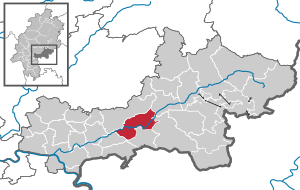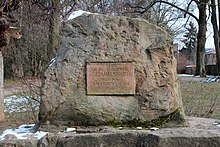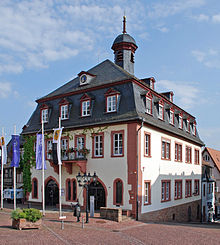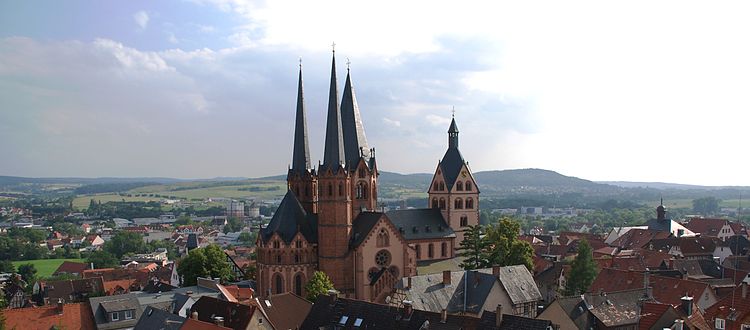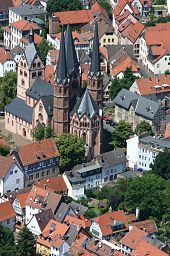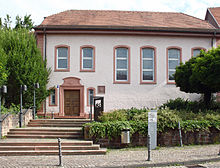Gelnhausen
| coat of arms | Germany map | |
|---|---|---|

|
Coordinates: 50 ° 12 ' N , 9 ° 12' E |
|
| Basic data | ||
| State : | Hesse | |
| Administrative region : | Darmstadt | |
| County : | Main-Kinzig district | |
| Height : | 159 m above sea level NHN | |
| Area : | 45.19 km 2 | |
| Residents: | 23,202 (Dec. 31, 2019) | |
| Population density : | 513 inhabitants per km 2 | |
| Postcodes : | 63571, 63589 | |
| Area code : | 06051 | |
| License plate : | MKK, GN, HU , SLÜ | |
| Community key : | 06 4 35 010 | |
| City structure: | 6 city districts / districts | |
City administration address : |
Obermarkt 7 63571 Gelnhausen |
|
| Website : | ||
| Mayor : | Daniel Christian Glöckner ( FDP ) | |
| Location of the city of Gelnhausen in the Main-Kinzig district | ||
The Barbarossastadt Gelnhausen [ ɡɛlnˈha͜uzn̩ ] is the district town of the Main-Kinzig-Kreis in the southeast of Hesse . The former imperial city lies halfway between Frankfurt am Main and Fulda on the eastern edge of the Rhine-Main area .
geography
Geographical location
Gelnhausen is located on the southern edge of the Büdinger Forest in the Kinzig valley. The forest is a Büdinger north over the Kinzig projecting Spessart streamers, which is counted to the Hessian-Franconian Bergland (code 14). This branch pushes itself from the south in front of the south-facing roof of the Vogelsberg, facing the Rhine-Main lowlands (code number 23) . As a north-west-south-east running red sandstone block from 350 to 410 m height, it essentially forms a sandstone plateau , on whose loamy sandy soil there is an almost closed forest area, for the most part deciduous forests , including noble deciduous tree forests that are worthy of protection. The landscape is of great importance as a recreational area. The large, uncut area north of Gelnhausen is particularly important for the biotope network. On the border to Vogelsberg in the northern part of the district of Breitenborn belonging to the municipality of Gründau , on the other hand, there are basalt ceilings and one of the largest basalt quarries in Hesse.
The Kinzig, which was navigable from Gelnhausen in the Middle Ages, flows through the landscape in a wide, flat Muldental valley from east to west and through the city on the southern edge.
Between 2007 and 2013, due to the EU expansion, the geographic center of the EU was exactly 50 ° 10 ′ 21 ″ N , 9 ° 9 ′ 0 ″ E in the southernmost part of Meerholz, a district of Gelnhausen - in the middle of a field at the foot of the " Niedermittlauer Heiligenkopf ”. On January 26, 2007, the Hessian European Minister Volker Hoff symbolically hoisted a flag of the European Union at this point .
climate
The annual precipitation is 859 mm. The precipitation is in the upper quarter of the measuring points of the German Weather Service . 73% indicate lower values. The driest month is February; it rains most in June. In the wettest month, around 1.5 times more rain falls than in the driest month. The seasonal fluctuations in precipitation are in the lower third. In only 3% of all places, the monthly precipitation fluctuates less.
Neighboring communities
Gelnhausen borders the municipality of Gründau in the north and west , the city of Wächtersbach in the northeast, the municipality of Biebergemünd in the east and the municipality of Linsengericht and the municipality of Hasselroth in the south .
City structure
In addition to the city center (Mitte district), Gelnhausen consists of the districts of Hailer , Haitz with Kaltenborn, Höchst , Meerholz and Roth .
history
With the elongated lower and upper market, five preserved gate towers and parts of the old city fortifications, the former imperial city has retained its medieval character.
In the first half of the 12th century, a branch of the noble family of Reginbodones (previously located in Langenselbold ) named themselves after Gelnhausen, the Counts of Selbold-Gelnhausen .
The city of Gelnhausen was founded in 1170 by Emperor Friedrich I (Barbarossa) , which earned it the nickname " Barbarossastadt " , which is known today .
The flowering was short-lived. The pledging of the city by the later Emperor Charles IV in 1349 and the Thirty Years' War threw it back on regional importance.
On the night of June 3rd to 4th, 1938, which is known as the “Gelnhäusner Kristallnacht”, the two doors of the synagogue were bricked up and stones were thrown at the windows of the synagogue and the Jewish community center. In the November pogrom of 1938 , the building remained unmolested. The former synagogue has been a cultural center since 1986.
1974 Gelnhausen initially lost the status of a district town that had existed since the time of the Electorate of Hesse. In July 2005, however, the administration of the Main-Kinzig district was relocated here from Hanau . Instead of HU, the district received the MKK license plate. Since January 1, 2013, the old “GN” label has been re-issued.
Since a heavy hailstorm in the Middle Ages, which saved the city from extensive destruction by a conflagration, the so-called Hail Day has been celebrated every year on August 15 as part of an ecumenical service.
Historical forms of names
In historical documents, the place is documented under changing place names over the centuries :
- Geylhausen (1058)
- Geilenhusen, de (1133)
- Gelenhusen (1158)
- Geilnhusen (1170)
- Gelnhusen (1223)
- Geilenhusen, de (1232)
Incorporations
In the course of the regional reform in Hesse on July 1, 1970, the previously independent municipalities of Haitz and Roth were incorporated into Gelnhausen on a voluntary basis . On April 1, 1971, Hailer joined them. Höchst and Meerholz followed by state law on July 1, 1974.
Population development
(From 1998: on December 31st)
- 1821: 2,613 inhabitants
- 1998: 21,656 inhabitants
- 1999: 21,750 inhabitants
- 2000: 21,799 inhabitants
- 2001: 21,835 inhabitants
- 2002: 21,670 inhabitants
- 2003: 21,773 inhabitants
- 2004: 21,808 inhabitants
- 2006: 21,763 inhabitants
- 2007: 21,660 inhabitants
- 2009: 21,496 inhabitants
- 2011: 21,863 inhabitants
- 2012: 22,163 inhabitants
- 2013: 22,350 inhabitants
- 2014: 22,519 inhabitants
- 2016: 22,796 inhabitants
- 2017: 22,873 inhabitants
- 2018: 23,073 inhabitants
religion
The following churches and religious communities exist in Gelnhausen:
- Evangelical : Evangelical parishes of Gelnhausen and Haitz / Höchst, Meerholz-Hailer, Gelnhausen-Roth.
- Catholic : St. Peter, Maria-Königin Meerholz-Hailer, St. Wendelin Gelnhausen-Höchst.
- Free church :Gelnhausen Adventist Church , Evangelical Free Church Church ( Baptists ) Gelnhausen-Meerholz, Church of the Nazarene .
- Islamic : Eyup Sultan Mosque, Merkez Mosque.
politics
City Council
The city council is the highest body of the city. Its political composition is determined every five years in local elections by the city's electorate. Whoever has reached the age of 18 and is a German citizen within the meaning of the Basic Law or a citizen of one of the other member states of the European Union may vote. Everyone has to have been registered in the city for at least three months.
The local elections on March 6, 2016 produced the following results, compared to previous local elections:
| Nominations | SPD | CDU | BG b | GREEN | FDP | left | NPD | REP | Distribution of seats | |
|---|---|---|---|---|---|---|---|---|---|---|
| 2016 | Voting share a | 45.9 | 22.8 | 15.7 | 7.9 | 7.7 | - | - | - |
 |
| Seats (37 in total) | 17th | 8th | 6th | 3 | 3 | - | - | - | ||
| 2011 | Voting share a | 42.8 | 28.8 | 7.7 | 12.1 | 4.2 | 3.5 | 0.9 | - |
 |
| Seats (37 in total) | 16 | 11 | 3 | 4th | 2 | 1 | - | - | ||
| 2006 | Voting share a | 33.2 | 41.5 | 14.1 | - | 6.1 | 5.0 | - | - |
 |
| Seats (37 in total) | 12 | 16 | 5 | - | 2 | 2 | - | - | ||
| 2001 g | Voting share a | 29.7 | 44.6 | 12.6 | 6.6 | 2.7 | - | - | 2.6 |
 |
| Seats (37 in total) | 11 | 17th | 5 | 2 | 1 | - | - | 1 | ||
| 1997 | Voting share a | 25.1 | 47.9 | 11.9 | 8.0 | - | - | 0.6 | 6.4 |
 |
| Seats (37 in total) | 9 | 18th | 5 | 3 | - | - | - | 2 | ||
37 city councilors and the city's local councils had to be elected for the legislative period from April 1, 2016 to March 31, 2021. Out of 17,746 eligible voters, 9,137 voted. As a result, the turnout increased from 48.9% in 2011 to 51.5% in 2016.
The parliamentary group chairmen in the city council are:
|
|
|
mayor
On October 15, 2017, Daniel Christian Glöckner ( FDP ) was elected as the new mayor. On November 16, 2017, Glöckner takes over the official business. He is one of ten FDP mayors in Hesse and the first in the Main-Kinzig district.
coat of arms
The oldest known version of the coat of arms is from the 15th century. It shows the shield that is in the middle of today's coat of arms. The eagle appeared around 1248. The coat of arms of that time showed the imperial eagle in a city gate. The emperor and his wife were on the gate. In later times this eagle appeared on all seals - sometimes under a city gate, sometimes alone. In the 16th century a small breast shield was added to the coat of arms, which is an image of the original coat of arms from the 15th century. In the 18th and 19th centuries, the theme varied in many ways: an eagle with a shield (both one and two-headed), the eagle without a shield, or just the shield.
The current version of the coat of arms dates from 1964 and is based on a coat of arms from the 16th century.
Town twinning
-
 Clamecy (Nièvre) , France since 1962
Clamecy (Nièvre) , France since 1962 -
 Marling (South Tyrol) , Italy since 1977
Marling (South Tyrol) , Italy since 1977
Culture and sights
Museums
Local museum
The building of the former Augusta School on the north side of the Obermarkt houses the local history museum. It was completely renovated in 2016 and restructured into an adventure museum. People from the city's history such as the city's founder, Emperor Friedrich Barbarossa, Baroque writer Grimmelshausen and telephone inventor Philipp Reis are introduced. Participatory elements such as a "smell organ", historical clothing including knight armor to try on and a hands-on rucksack are to turn the new museum into an adventure museum under the motto "Look, touch, play, smell - discover history with all your senses". For children, the museum has its own text level at eye level. The accessible ear is also located in the museum. The accessible ear is accessible on Sundays at 2 p.m.
Tower clock museum
This museum, which is run by a private person, shows 35 tower clockworks from the years 1520 to 1996. There are also a number of individual parts and accessories on display.
Airplane Museum
Until 2013 there was the privately operated "Museum for Aircraft Technology and History Friedhelm Wagner" in the district of Hailer. More than 3,200 exhibits from the field of aviation were shown in seven rooms on an area of over 200 square meters. In addition to engines, units, instruments and on-board accessories, original documents were also on display. Particular attention was paid to aviation in the Kinzig valley.
Buildings
Imperial Palace
The Kaiserpfalz (also called "Barbarossaburg") was built immediately after the city was founded, around 1170 southeast of Gelnhausen on a Kinziginsel - probably on the site of the former Reginbodonen castle . It was one of Barbarossa's smaller palatinate buildings . In addition to its function as the palace of the German king, it also served as the administrative seat for the royal estate around the palace building. In order to underline its function, it was built at a clearly visible distance from the actual urban area. This led to the effect that by 1895 the cluster of buildings around the castle had formed an independent community called "Burg".
Ten years after the city was founded, the Palatinate was the site of an important Reichstag . Henry the Lion was tried in absentia at this Diet in 1180, and his lands were redistributed.
The Gelnhausen privilege was issued here in 1186 .
The imperial palace is the best preserved palace from the Staufer period. Your stone carvings are outstanding for the time. About 12,000 tree trunks served as the foundation for their construction.
Due to the structural expansion of the city, the Kaiserpfalz is now in the middle of the town center. Today it is one of the most important sights of Gelnhausen, which can also be visited by visitors.
Romanesque house
In the Middle Ages, the building on Untermarkt, which was particularly richly decorated on the front with Staufer building elements, was the seat of the imperial bailiff and the imperial court of the imperial city, then probably also of the mayor and council, until they moved to the town hall on Obermarkt, a former trading house. The Romanesque House is owned by the Protestant parish today, and the medieval town hall on the Obermarkt is still used today.
Witch tower
The Hexenturm is an originally preserved turret from the middle of the 15th century. It was built between 1447 and 1478 during the Hussite Wars to protect the city against attacks by the Taborites (a radical group of Hussites). Their armament also included smaller siege guns. Since these were permanently mounted on the wagons of the train, they represented an unknown danger in this form. With a total height of 24 meters and a diameter of 9 meters, the round tower, which was quite considerable for its time, was a reaction to this technical innovation. The building was based on the existing city wall. Its position was chosen so that the bridge between Gelnhausen and the municipality of Burg could be protected from it.
In the first time of its existence the tower was called Fratzenstein . It was given the name Hexenturm because alleged witches were imprisoned there during the witch hunts. From 1584 to 1633 at least 54 people, mostly women, were accused, tortured and executed of alleged witchcraft in Gelnhausen. One of them was Elisabeth Strupp , the wife of the Gelnhausen pastor Johannes Strupp, who was executed here in 1599.
After the renovation of the tower, a memorial plaque with 31 names of victims of this paranoia and the sculpture by the artist Eva-Gesine Wegner “Die Rufende” was installed in the garden of the former fortification tower in April 1986. There is an exhibition on the history of the witch hunt on the upper floor of the building.
Inner wooden gate
The first stone city wall around Gelnhausen dates back to 1220. In addition, the city was secured with shell towers that had a square floor plan. The side facing away from the city was built of stone, the side facing the city was closed with wooden bowls for cost reasons. The towers are round on the side facing away from the city so that cannon shots could not damage the towers as much.
Evangelical Marienkirche
The Marienkirche in Gelnhausen is the former church of the Premonstratensian monastery Langenselbold. It probably dates from the late 12th century and was first documented in 1223 in a letter of protection from Pope Honorius III. mentioned for the monastery Selbold . In this document, which was confirmed by another in 1238, the Pope assured the canons of Selbold Monastery the patronage rights over the Marienkirche. This decision had a corresponding impact on the construction of St. Peter's Church .
The Marienkirche remained in its possession until the monastery was dissolved in 1543. At that time, the church became Lutheran under a contract with the city of Gelnhausen. This peaceful process and the later resistance of the city against the introduction of the Reformed denomination in Gelnhausen had a clear impact on the Marienkirche. The iconoclasm did not take place and the interior of the church (especially the altars and the medieval rood screen ) was largely preserved.
The various building phases of the church are partly quite clearly visible in their exterior and interior. The original single-nave building, probably dating back to 1120 (the west portal is preserved), was expanded into a three-aisled basilica in the Staufer period. The nave of the church and the west tower are built in the Romanesque style . The originally Romanesque side aisles have been expanded to include Gothic elements. For example, the original windows were bricked up and replaced with Gothic windows above them. Moving eastwards, the building belongs to the early Gothic period.
The first major restoration work began in 1877. These mainly served to preserve the southern tower. From 1945 the war damage was gradually repaired. Since about 1962 the church has been restored in several stages. Many of the works from the 19th century were reversed or their form defused. For example, the pulpit built in the 19th century was replaced by the wooden pulpit from the Renaissance period. A foundation is set up for the continued preservation of the church. The first result of their work was renovation work on the five medieval choir windows in 2000.
Catholic Church of St. Peter
The origin of St. Peter is in the early 13th century. After the Reformation it was given up as a church and used elsewhere - at times even as a cigar factory. In 1920 the Roman Catholic parish bought the building and had it ready for worship purposes again.
Former synagogue
The former synagogue in Gelnhausen dates back to 1656 and survived the November pogroms of 1938 because the Jewish community had already disbanded by then, under the political pressure and terror of the Nazis. The synagogue still has a baroque Torah shrine and has been a place of cultural encounter in Gelnhausen since 1986. The mikveh and the former school no longer exist .
Jewish Cemetery
The Gelnhausen Jewish cemetery is located below the ship gate near the Kinzig . It was laid out in the late Middle Ages or the early modern period and was used until 1938.
freetime and sports
The following cycle paths lead through Gelnhausen :
- The BahnRadweg Hessen runs on former railway lines for approx. 250 km through the Vogelsberg and the Rhön.
- The Hessian long -distance cycle route R3 runs as the Rhein-Main-Kinzig cycle route from Rüdesheim to Tann in the Rhön .
In addition to many other numerous sports clubs and service providers, the athletes Harald Schmid and Edgar Itt , who started for the gymnastics club Gelnhausen (TVG) in the 1980s and 1990s, as well as the siblings Karin and Ute Lix became known nationally and internationally.
The handball department of the gymnastics club has provided successful teams for many years. The first men's team is currently playing in the third league east and the A-youth team is playing in the first division for the second year running (season east).
Diver Dieter Dörr , who started for the swimming club in Gelnhausen , took part in the Olympic Games in Montreal (1976) and Los Angeles (1984). The women's and men's teams of the swimming club swam in the 2nd Bundesliga for many years.
The basketball club BC Gelnhausen plays in the 2nd regional league for the 2012/2013 season.
In Gelnhausen there is an interactively accessible ear in memory of Philipp Reis, the inventor of the telephone.
Regular events
Folk festivals take place regularly in Gelnhausen. On the second weekend in March the “Barbarossamarkt” and on the second weekend in October the “Schelmenmarkt” with all kinds of rides and other attractions. The "Schelmenmarkt" is the largest festival in the Kinzig valley. The name goes back to the rogues of mountains , a branch of which was based in Gelnhausen.
Once a year in spring, after the motorcycle church service in the Niedergründau mountain church, the starter takes place on the fairground. This is considered to be one of the largest motorcycle meetings in Germany.
In July, the Homerun Open Air takes place on the parade ground.
Grimmelshausen Prize
The Johann Jacob Christoph von Grimmelshausen Prize is a literary prize endowed with 10,000 euros. It is awarded every uneven year on September 15, alternately in Gelnhausen and in the city of Renchen . In addition to the literature prize, the Grimmelshausen sponsorship prize has been awarded to authors who have not yet been established since 2003.
Philipp Reis Prize
The Johann Philipp Reis Prize was donated in 1987 on the occasion of the 125th anniversary of the presentation of the telephone by Philipp Reis . The foundation is supported by the cities of Gelnhausen and Friedrichsdorf as well as Deutsche Telekom AG and the VDE Association of Electrical, Electronic and Information Technologies . Since then, the award has been given every two years to people who have made outstanding contributions to communications technology.
Kinzigtal totally
Once a year, the Kinzigtal Total Cycle Sunday takes place.
Economy and Infrastructure
A notable company based in Gelnhausen is the automotive supplier Veritas . In 2016 it achieved an annual turnover of 619 million euros and employed a total of 4,000 people.
traffic
Gelnhausen is located on the A 66 between Frankfurt am Main and Fulda . There are two motorway junctions: "Gelnhausen-West" (43) and "Gelnhausen-Ost" (44). The federal highway 457 connects Gelnhausen with the neighboring Wetteraukreis , especially with the neighboring town Büdingen .
The federal highways 40 and 43, which previously ran through Gelnhausen, were handed over to the state of Hesse and the Main-Kinzig district in the course of the construction of the A 66 and converted into state and district roads.
The Station Gelnhausen located on the Kinzig Valley Railway , as part of the Frankfurt-Bebra Railway was built. Regional traffic from Fulda to Frankfurt (RE 50) and from Wächtersbach to Frankfurt (RB 51) stop here . The regional trains from the Gießen – Gelnhausen railway line (RB 46) have their terminus here. The Freigerichter Kleinbahn and the narrow-gauge Spessartbahn of the Gelnhauser Kreisbahnen were shut down decades ago .
In the west of the city there is a public airfield that is suitable for small aircraft up to 3.5 tons. Motor planes, helicopters and UL aircraft as well as gliders take off and land there .
The so-called “Philosophenweg”, a panoramic path with views of the city with the Marienkirche and the Kinzig valley, runs on the slopes of the Gelnhausen city forest. Another network of approx. 170 km of marked hiking trails is accessible from the Auf der Dürich hiking car park (“Zum Blockhaus” restaurant). The Hessian long-distance cycle route R3 also goes through Gelnhausen.
media
The local press organ is the Gelnhäuser Neue Zeitung .
Public facilities
The district court and a juvenile detention center are located in Gelnhausen .
- Federal Agency for Technical Relief (THW): Regional office for the Gelnhausen regional area (East Hesse) and local association
- Office for Roads and Transport Gelnhausen
- Gelnhausen police station
- Employment agency Gelnhausen office
- Gelnhausen tax office
- Main-Kinzig-Kliniken Gelnhausen
- Emergency response center of the Main-Kinzig district and the control center
Troop deployment
Until the 1990s, numerous American soldiers were permanently stationed in Gelnhausen. The most famous GI was the future Secretary of State Colin Powell in the 1960s . He was then the namesake of a street in the area of the former Coleman barracks . Today only two smaller areas are still inhabited. The former barracks in the west of the city are now mainly home to industrial companies, start-ups and a number of public authorities.
Mining
In the southern part of the city there are evidence of the mining of metal ores, which was first mentioned in 1400. See also: List of mines in the Spessart
education
The following schools are located in Gelnhausen:
- The district secondary school Gelnhausen (Gelnhausen-Mitte)
- The Grimmelshausen High School (Gelnhausen-Mitte)
- The Philipp Reis School (Gelnhausen-Mitte)
- The vocational schools in Gelnhausen (Gelnhausen-Mitte)
In addition, the following adult education institution of supraregional importance is located in Gelnhausen:
- The Burckhardthaus, an advanced training institute of the Evangelical Church in Germany , is also connected to the advanced training center for leadership and leadership; Sponsor: Evangelical Institute for Youth, Cultural and Social Work e. V.
Personalities

Honorary citizen
- Heinrich Kreß (1902–1985), District Administrator, Member of Parliament (CDU)
- Jürgen Michaelis, Mayor of the Barbarossa town of Gelnhausen from 1977 to 2007
Gelnhausen personalities
- Siegfried von Gelnhausen († 1321), castle chaplain in Gelnhausen, 1298 to 1321 Bishop of Chur.
- Heinrich Mohn (engineer) (1904–2003), engineer, inventor and philanthropist.
- The Monks , influential rock band of the 1960s.
- Colin Powell (* 1937), United States Secretary of State from 2001 to 2005.
- Harald Schmid (athlete) (* 1957) multiple Olympic medalist.
- Edgar Itt (* 1967) Olympic medalist in athletics.
- Peter Tauber (* 1974), German politician (CDU).
sons and daughters of the town
- Konrad von Gelnhausen (around 1320 / 25–1390), theologian and first chancellor of Heidelberg University
- Johannes von Gelnhausen (before 1350 – after 1407), notary (including Emperor Charles IV) and translator
- Jost Hoen (around 1500–1569), master's degree, educator and statesman
- Elisabeth Strupp († 1599), wife of the Gelnhausen pastor Johannes Strupp, was executed after a witch trial
- Johann Jacob Christoffel von Grimmelshausen (around 1622–1676), writer ( Der adventurous Simplicissimus )
- Johann von Pfalz-Birkenfeld (1698–1780), Count Palatine and Duke of Zweibrücken-Birkenfeld zu Gelnhausen, direct ancestor of Elisabeth, Empress of Austria, known as Sissi
- Johann Heinrich Cassebeer (1784–1850), scientist and mayor of Gelnhausen
- Philipp Reis (1834–1874), physicist; the telephone he introduced in 1861 is considered his invention
- August Brey (1864–1937), politician (SPD), MdR, MdL (Prussia)
- Karl Kalbfleisch (1868–1946), classical philologist
- Theodor Etzel (1873–1930), writer
- Julius Frey (1895–1965), politician (CDU), first freely elected mayor of the city of Gelnhausen after 1945
- Friedrich Hueter (1897–1967), administrative lawyer
- Oskar Fischinger (1900–1967), film director
- Hans Fischinger (1909–1944), film director
- Hans Joachim Fröhlich (1923–2008), forest scientist
- Helga Elstner (1924–2012), politician (SPD), member of the Hamburg Senate and member of the Hamburg Parliament
- Gerhard Wettig (* 1934), historian
- Roland Vogt (1941–2018), politician (Greens) and pacifist
- Jan Kahmann (* 1947), trade unionist
- Rolf Müller (* 1947), politician (CDU), MdL Hessen, State Secretary, President of the State Sports Association of Hesse
- Rudi Bresser (* 1948), economist
- Richard Meng (* 1954), journalist
- Klaus Ploghaus (* 1956), hammer thrower (bronze medal at the 1984 Olympics)
- Ulrich Johannes Schneider (* 1956), librarian and historian of philosophy
- Andreas Gößling (* 1958), writer
- Rudolf Michl (* 1958), politician (SPD)
- Dirk Schäfer (* 1961), director and documentary filmmaker
- Peter Back (* 1962), jazz musician
- Burkhard Kling (* 1962), art historian, museum director
- Hans-Jürgen Gundelach (* 1963), football player
- Diana Hummel (* 1963), political and environmental scientist
- Wolfram Weimer (* 1964), journalist
- Stefanie Dehnen (* 1969), chemist
- Mariana Harder-Kühnel (* 1974), lawyer and politician
- Tia Mowry-Hardrict (born 1978), actress
- Rene Schwuchow (* 1978), talk show host
- Jessica Gutermann (* 1984), volleyball and beach volleyball player
- Michelle Weitzel (* 1987), track and field athlete
- Marcos Álvarez (* 1991), football player
- Kim Naidzinavicius (* 1991), handball player
literature
- Jürgen Ackermann: Gelnhausen. The pledged imperial city. Civil liberty and ruling power. (Studies and materials on constitutional and regional history, Volume 22), Marburg 2006. ISBN 3-921254-87-6 .
- Magistrate of the Barbarossastadt Gelnhausen (ed.): Near Gelnhausen Castle - a new city (825 years of city history), Gelnhausen 1995, ISBN 3-924417-09-1 .
- German city atlas. Vol. 1.4. Acta Collegii Historiae Urbanae Societatis Historicorum Internationalis - Series C. On behalf of the Board of Trustees for Comparative Urban History e. V. and with the support of the German Research Foundation, ed. by Heinz Stoob, Wilfried Ehbrecht, Jürgen Lafrenz and Peter Johanek. City map Gelnhausen. Dortmund-Altenbeken 1973, ISBN 3-89115-304-X .
- Wolfgang Hartmann: From the Main to Trifels Castle - from Hirsau Monastery to Naumburg Cathedral. On the traces of the Franconian noble family of the Reginbodonen in the Middle Ages. In: Publications of the History and Art Association Aschaffenburg e. V. Pattloch, Aschaffenburg 52.2004, ISBN 3-87965-098-5 ( information about the book ).
- Walter Hotz : Gelnhausen (The Little Art Guide). Amorbach 1951.
- Magistrate of the Barbarossastadt Gelnhausen (ed.): Former synagogue Gelnhausen. Dedication as a cultural meeting place September 25, 1986 , Gelnhausen 1986.
- Rolf Müller: Old Gelnhaus tell . 2 volumes. Gelnhausen Naumann [u. a.] 1980, 1991.
- Georg Wilbertz: The Marienkirche in Gelnhausen , Königstein i. Ts. 2000 (The Blue Books), ISBN 978-3-7845-0590-9
- Christine Wittrock : loyal to the emperor and believing in the leadership. Impressions from the old Gelnhausen district 1918–1950. ISBN 3-937774-27-0 .
- Thomas Weyrauch: Guild and craft documents of the free imperial city of Gelnhausen . Laufersweiler, Wettenberg 2004 (2nd edition). ISBN 3-930954-01-X .
- Thomas Weyrauch: Gelnhausen. In: Concise dictionary of German legal history (HRG). 2nd edition Berlin (Erich Schmidt) Volume 2, 1st delivery, columns 45 f., 2009
- Bernhard Ebert, Peter Musall: Barbarossastadt Gelnhausen. A small town with a great history . Brentano bookstore, Gelnhausen, 1990.
- City administration Gelnhausen (Hrsg.): Gelnhausen, the Barbarossastadt. 800 years of city rights . Bethge, Bad Homburg 1970.
- Hans-Jürgen Freund: Carl Andreas Roth - master baker by tradition - poet by passion. Portrait of the writing master baker , born in Gelnhausen in 1859 , TRIGA - Der Verlag, Gründau-Rothenbergen. ISBN 978-3-89774-683-1
Individual evidence
- ↑ Hessian State Statistical Office: Population status on December 31, 2019 (districts and urban districts as well as municipalities, population figures based on the 2011 census) ( help ).
- ↑ Earth of all European member states for the center of the European Union ( page no longer available , search in web archives ) , Hessian State Chancellery May 9, 2008
- ↑ The current focus of the EU: Westergrund municipality - VG Schöllkrippen. Retrieved July 19, 2020 .
- ^ Daniel Hanke: The history of the Jews in Gelnhausen 1933-1938. Pp. 302, 315. Online
- ↑ Now there is GN and SLÜ again from December 28, 2012, accessed on February 11, 2013
- ^ "Gelnhausen, Main-Kinzig-Kreis". Historical local lexicon for Hesse (as of April 17, 2014). In: Landesgeschichtliches Informationssystem Hessen (LAGIS). Hessian State Office for Historical Cultural Studies (HLGL), accessed on July 11, 2014 .
- ↑ Incorporation of the communities Haitz and Roth in Hreisstadt Gelnhausen, Gelnhausen district from June 26, 1970 . In: The Hessian Minister of the Interior (Ed.): State Gazette for the State of Hesse. 1970 No. 28 , p. 1406 , point 13360 ( online at the information system of the Hessian state parliament [PDF; 3.7 MB ]).
- ↑ Law on the reorganization of the districts of Gelnhausen, Hanau and Schlüchtern and the city of Hanau as well as the recirculation of the cities of Fulda, Hanau and Marburg (Lahn) concerning questions (GVBl. 330-26) of March 12, 1974 . In: The Hessian Minister of the Interior (ed.): Law and Ordinance Gazette for the State of Hesse . 1974 No. 9 , p. 149 , § 6 ( online at the information system of the Hessian state parliament [PDF; 3.0 MB ]).
- ^ Federal Statistical Office (ed.): Historical municipality directory for the Federal Republic of Germany. Name, border and key number changes in municipalities, counties and administrative districts from May 27, 1970 to December 31, 1982 . W. Kohlhammer, Stuttgart / Mainz 1983, ISBN 3-17-003263-1 , p. 362-363 .
- ↑ Number after: Thomas Klein: Outline of German Administrative History 1815-1845 . Row A: Prussia. Volume 11: Hessen-Nassau including predecessor states. Marburg 1979, p. 110.
- ^ Mosques in Gelnhausen. Mosque search, accessed July 19, 2020 .
- ^ Result of the municipal election on March 6, 2016. Hessian State Statistical Office, accessed in April 2016 .
- ↑ Hessian State Statistical Office: Results of the municipal elections of 2011 and 2006
- ↑ Hessian Statistical Office: Results of the municipal elections of 2001 and 1997
- ^ Hessenschau: Thousands of motorcyclists open the season. (No longer available online.) In: hessenschau.de. April 23, 2017, archived from the original on May 19, 2017 ; Retrieved April 23, 2017 .
- ↑ Sven Väth plays at the "Homerun Open Air 2017". In: Hanauer Anzeiger from May 23, 2017.
- ↑ MKK - Danger Defense Center. In: mkk.de. June 1, 2004, accessed August 9, 2018 .
Web links
- Official website of the city of Gelnhausen
- Gelnhausen, Main-Kinzig district. Historical local dictionary for Hessen. In: Landesgeschichtliches Informationssystem Hessen (LAGIS).
- Literature by and about Gelnhausen in the catalog of the German National Library

